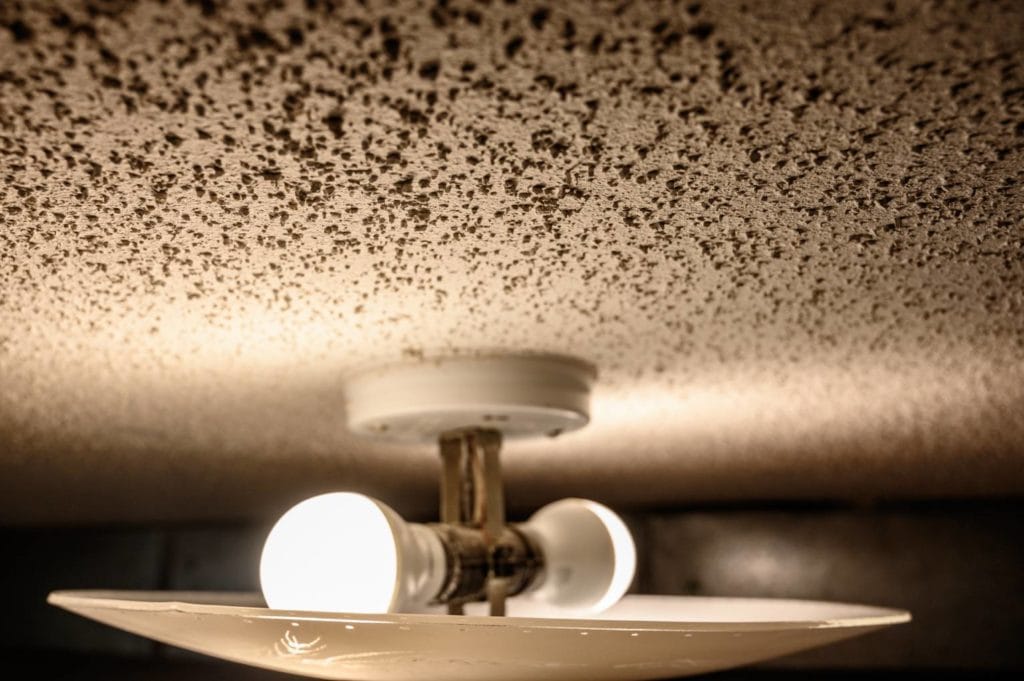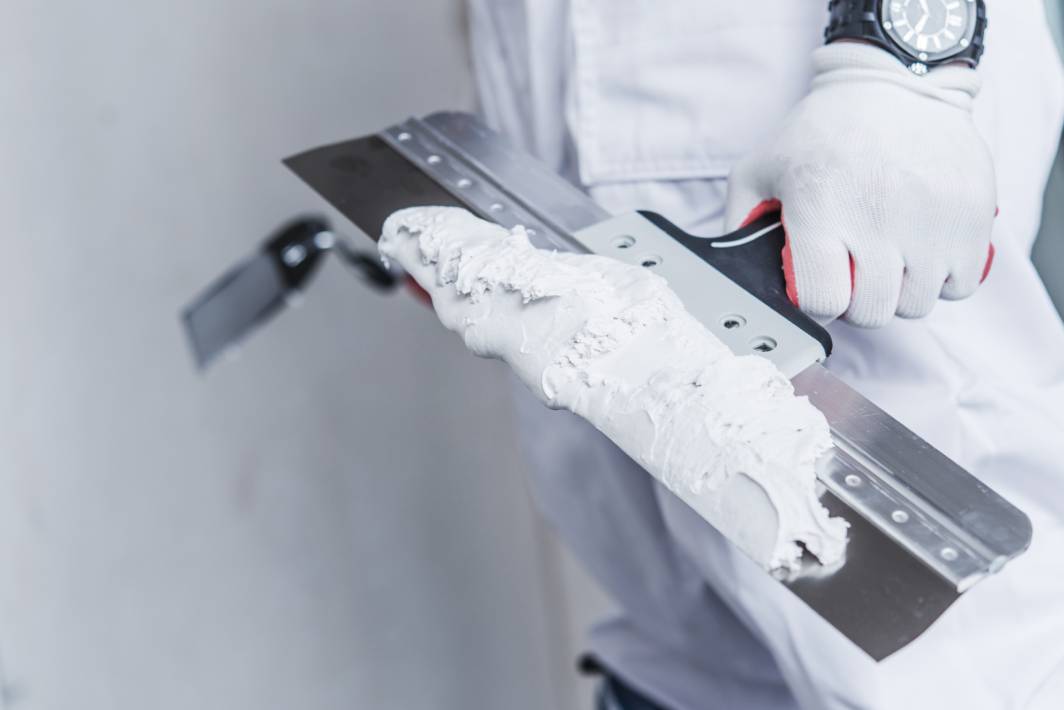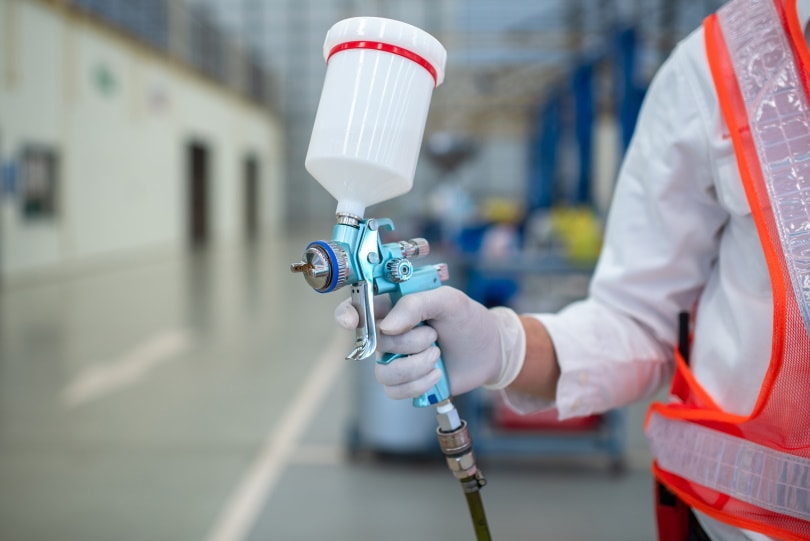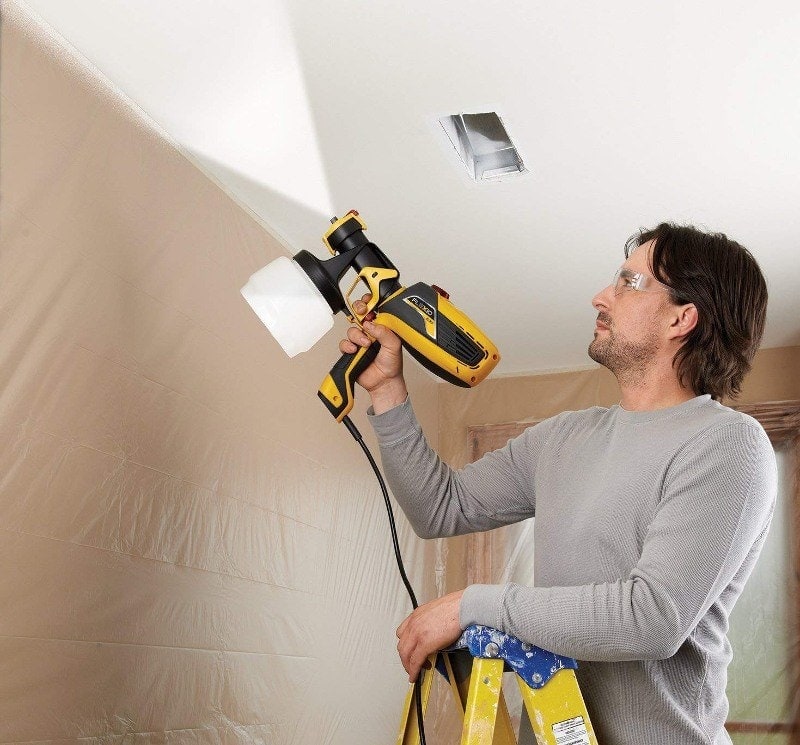How to Fix a Popcorn Ceiling in 6 Steps (with Pictures)
-
Pete Ortiz
- Last updated:

Before You Begin
It’s not difficult to patch a popcorn ceiling, but it does require a little bit of prep work ahead of time. With a step-by-step like this one, most DIYers are qualified to tackle this task. Like any home renovation project, make sure you have all the tools and supplies you will need before you begin so you don’t have to stop partway through.
Personal Protective Gear (PPG): Cut resistant gloves, safety glasses
Materials: Joint compound, joint tape, drywall board, primer, paint, drywall screws
Tools: Putty knives (four and six-inch), knife, drill, sanding block, spray bottle, stepladder
Optional: Mask, spray-on texture, vacuum
How to Fix a Popcorn Ceiling (6 Steps)
1. Prepare the Work Area
If you’ve ever watched someone patch a popcorn ceiling on those home renovation shows, you will notice one of two things. Either the room they are working in will be empty, or plastic will cover any furniture. This is due to the sheer amount of dust that will result from this project. It also protects from any damage from paint splatter at the end.
Before you touch the ceiling, you will want to prepare the room. The large plastic sheeting that painters use works great for this type of work, and it’s usually inexpensive at your local home building center.
Once you’ve cleared the floor below the area to be repaired and moved or covered any furniture, you’re ready to begin.
2. Remove Texture from Damaged Ceiling
IMPORTANT NOTE: Most joint compounds (this is used to texture ceilings) contained asbestos until the late 1970s. Asbestos is extremely harmful to your health. So, if your house is older than 1980, it’s a good idea to hire a qualified professional or at least have the texture tested for asbestos.
Soak the area being repaired with warm or hot water from your spray bottle. This will do two things. It will make the texture much easier to scrape off, and it will keep the dust down.
Before scraping, put on safety glasses to prevent chunks of the texture from falling into your eyes. Using your six-inch putty knife, clear the texture from the ceiling. You don’t have to get it perfect at this point because you may end up removing a chunk of drywall instead. Just clear enough so you can see how much the drywall itself is damaged.
3. Replace Damaged Drywall

Once you have cleared most of the texture from the area, determine whether the drywall needs replacing. If it is not soft or spongey from water damage and there are no significant holes, then you can move on to step five.
However, if there is severe water damage or holes, you should replace some drywall.
The easiest thing to do is figure out where the two closest rafters in the ceiling are on each side of the damage. Then, cut the drywall back to the middle of each rafter (the rafters will each be 1½ inches wide). Once you pull that chunk of the ceiling down, you should be left with a reasonably clean square or rectangle opening, depending on how much damage there was.
Measure how big the replacement drywall piece needs to be and cut it accordingly (make sure you wear cut-resistant gloves in case a slip happens while cutting).
Depending on how wide the piece you removed was, you will need 2 – 4 screws to secure the new drywall. And don’t forget to put the same number of screws in the existing ceiling where you cut back to in the rafters as it will be hanging loose now.
4. Apply Tape and Joint Compound if Drywall was Replaced
There are a couple of steps involved here due to a 24-hour drying time between coats of the joint compound—or, as some people call it, “mud.”
Before applying joint tape and compound, make sure to scrape approximately six inches of texture back from new joints in the ceiling.
First Coat
Using your four-inch putty knife, apply a layer of joint compound along the joint. Hold up the tape and rip a piece of the same length as the joint minus roughly a ½ inch at each end. Press the putty knife firmly in at an angle at one end, and in one motion, slide it along to the other. This should embed the tape into the mud against the joint and squeeze out all the excess.
Second Coat
After giving the first coat of joint compound and tape 24-hours to dry, you are ready for the final coat.
First, scrape any ridges in the dry compound flat. Then, spread a layer of mud over the tape using your six-inch knife. Do your best to smooth or “feather” the edge of the mud, so it’s flat as possible. However, because you are texturing over this joint, getting it 100% smooth is not as crucial as if this was a wall or it wasn’t getting a texture.
Once you’ve allowed the second coat of joint compound to cure, lightly sand the edges with a sanding block. The goal here is to make sure it’s relatively smooth, with no prominent ridges or bumps.
Note: Sanding will cause a lot of dust that is not healthy to inhale. Wearing a mask is recommended, and if you have a shop-vac, holding it up while you sand can significantly reduce the dust.
5. Spray or Sponge on New Texture

For the new texture, you have two options. A spray-on texture is the easiest route. Whereas sponging the texture is more precise, giving you greater control over the end result of matching the existing texture.
Spray-On
There are various brands to choose from, but they are all similar in their application. Essentially you will hold the can eight – ten inches away from the ceiling, depress the trigger, and sweep evenly back and forth. Make sure to follow specific directions on the can, as some vary slightly.
Sponging
To sponge the texture, you will need a course construction sponge. Dip the sponge in the same joint compound you used earlier and dab it onto the ceiling. Do this over and over, randomly. As you get to the existing texture, you can adjust your sponging to try and mimic the old texture closely.
As the compound starts to dry, you can also do a knock-down. Basically, take one of your putty knives and break the tips of the texture to flatten it slightly.
6. Prime and Paint the Repair
After your texture has dried for the required amount of time (usually 24-hours), you are ready for the final step—priming and painting. In most cases, a basic white primer is fine and then match whatever color your ceiling is. Keep in mind when purchasing paint that most ceiling paint has a flat sheen.
You only need to prime the repaired area. However, if the ceiling has not been painted in the last few years, then it may look better to paint the entire ceiling. There may be noticeable paint lines once you finish if you don’t.
If you only want to paint the patched area, then dry-rolling out from the repair will help blend the new paint with the old. Basically, dry-rolling is where you keep rolling out past the new area without reloading your paint roller. This is a common trick to blend old and new paint or paint with a slightly different tint or sheen.
Fixing a Small Hole in the Ceiling
If you find only a small hole in the ceiling once you scrape the old texture off, then it’s not necessary to cut a huge chunk out. Filling the hole with joint compound and embedding a piece of tape across the hole will be sufficient. After embedding the tape, make sure you still give it a final coat of compound to smooth it out.
 Conclusion
Conclusion
As you can see in this straightforward step-by-step, it doesn’t take any special training to patch a popcorn ceiling. However, if this is your first time doing any drywall work, prepare for a little bit of frustration. Mudding and taping is an art, but the beauty of popcorn texture is that it hides many of the imperfections. So even the most casual DIYer can accomplish this task and be proud of the result.
Related Read:
- How To: Popcorn Ceiling Removal in 7 Steps (with Pictures)
- How Much Does It Cost to Fix a Hole in Your Wall? Drywall Repair Costs
Featured Image Credit: Lost in the Midwest, Shutterstock
Contents



